In 2022, Nick Crew delved into Scanline VFX‘s role in The Adam Project. Following this, he transitioned to his work on the Yu Yu Hakusho series. Today, he sheds light on his return to the MonsterVerse with Godzilla x Kong: The New Empire.
Over the course of nearly 25 years, Eric Petey has immersed himself in the world of visual effects at various studios like Cinesite, DNEG, Digital Domain, and Scanline VFX. His filmography includes collaborations on many films such as 300: Rise of an Empire, Rampage, Spider-Man: Far From Home, and Godzilla vs Kong.
What is your background?
Eric // I studied 3D Animation at Vancouver Film School, after which I worked as a 3D generalist in Vancouver for a few years. Following that I took great advantage of the opportunities this career provides to work, and travel, in lots of interesting places around the world. I narrowed my focus over the years, specializing in creature work and animation – and I’ve been working as an Animation Supervisor since 2010.
How did you and Scanline VFX get involved on this show?
Nick // Scanline became involved early on, as soon as Production VFX Supervisor Alessandro (Ale) Ongaro and Production VFX Producer Thomas Elder-Groebe began looking for Vendors to tackle the various work in the film. We had a previous relationship with Legendary and Director Adam Wingard from Godzilla vs. Kong, and Scanline had also just worked with Ale on Netflix’s ‘The Adam Project’.
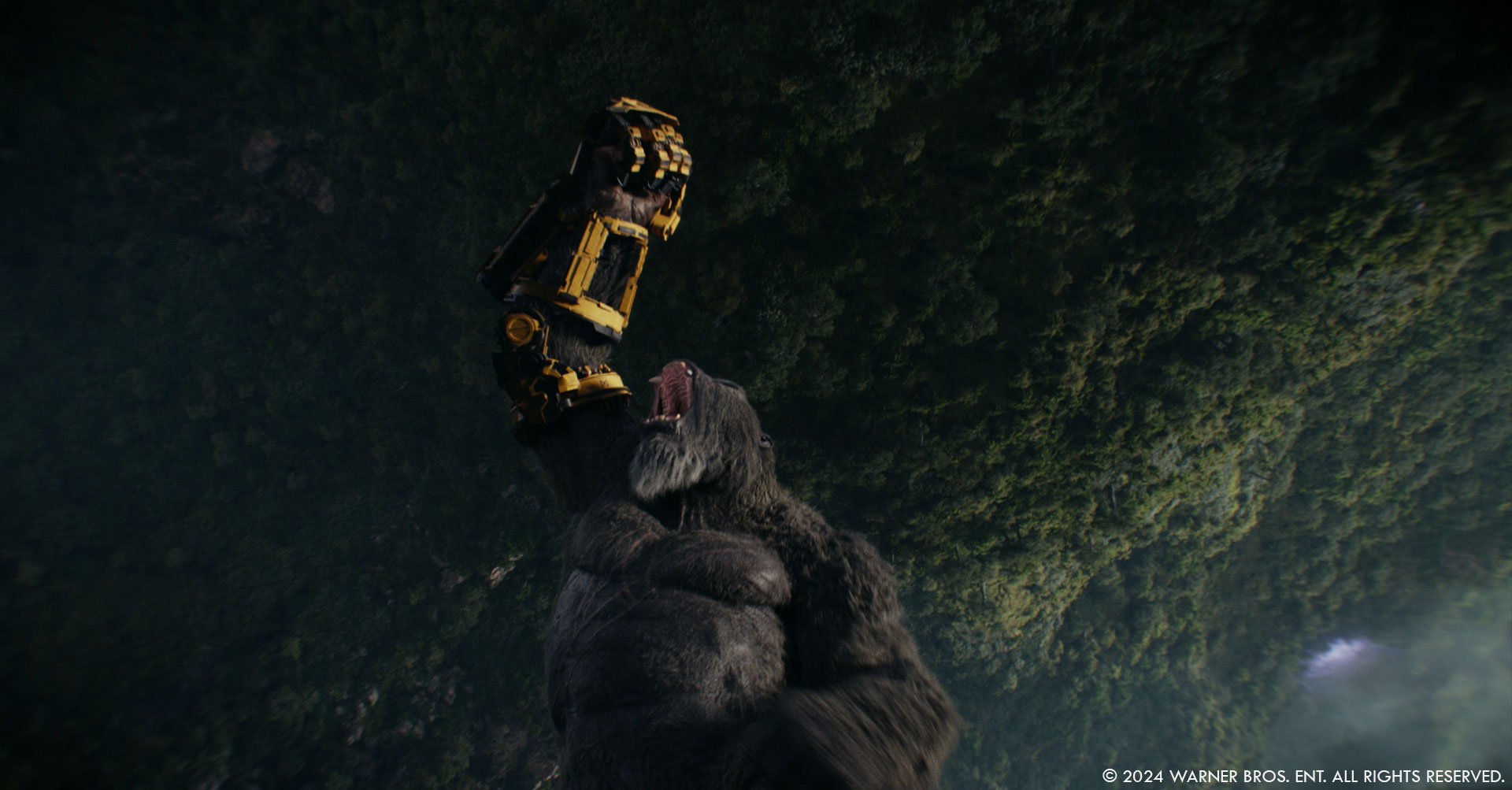
What was your feeling to be back into the MonsterVerse?
Eric // Thrilled of course! Giant monsters fighting *and* acting truly is the stuff of dreams for animators. Both myself and Bill Bridges (Animation Supervisor) had previously worked on Godzilla Vs Kong, so it was really great to have that continuity with Adam Wingard. Alessandro made it clear we were kicking the VFX up a notch from the previous film, with new Monsters and some pretty wild environments – so it was very exciting to jump into an ambitious new project while having some familiarity.
How was the collaboration with director Adam Wingard and VFX Supervisor Alessandro Ongaro?
Nick // It really was a fantastic team to collaborate with – I’m not just saying that because they might be reading! Adam and Ale allowed for a lot of creative exploration, while still offering clear guidance on the key items that were important to them in our sequences. We began in most cases with previs, and any major points of reference that they were hoping to see in our work. From there we were free to explore what we thought could make the sequence more visually interesting and engaging for audiences. This included pitching various environment designs throughout hollow earth, various FX designs for major destruction or FX beats, and animation alternatives to support the story and, in some cases, pacing.
After creatively brainstorming we would pitch our ideas to Ale, and refine them based on how he and/or Adam reacted. This allowed our entire team to feel like they had room to creatively explore in an open and collaborative environment.
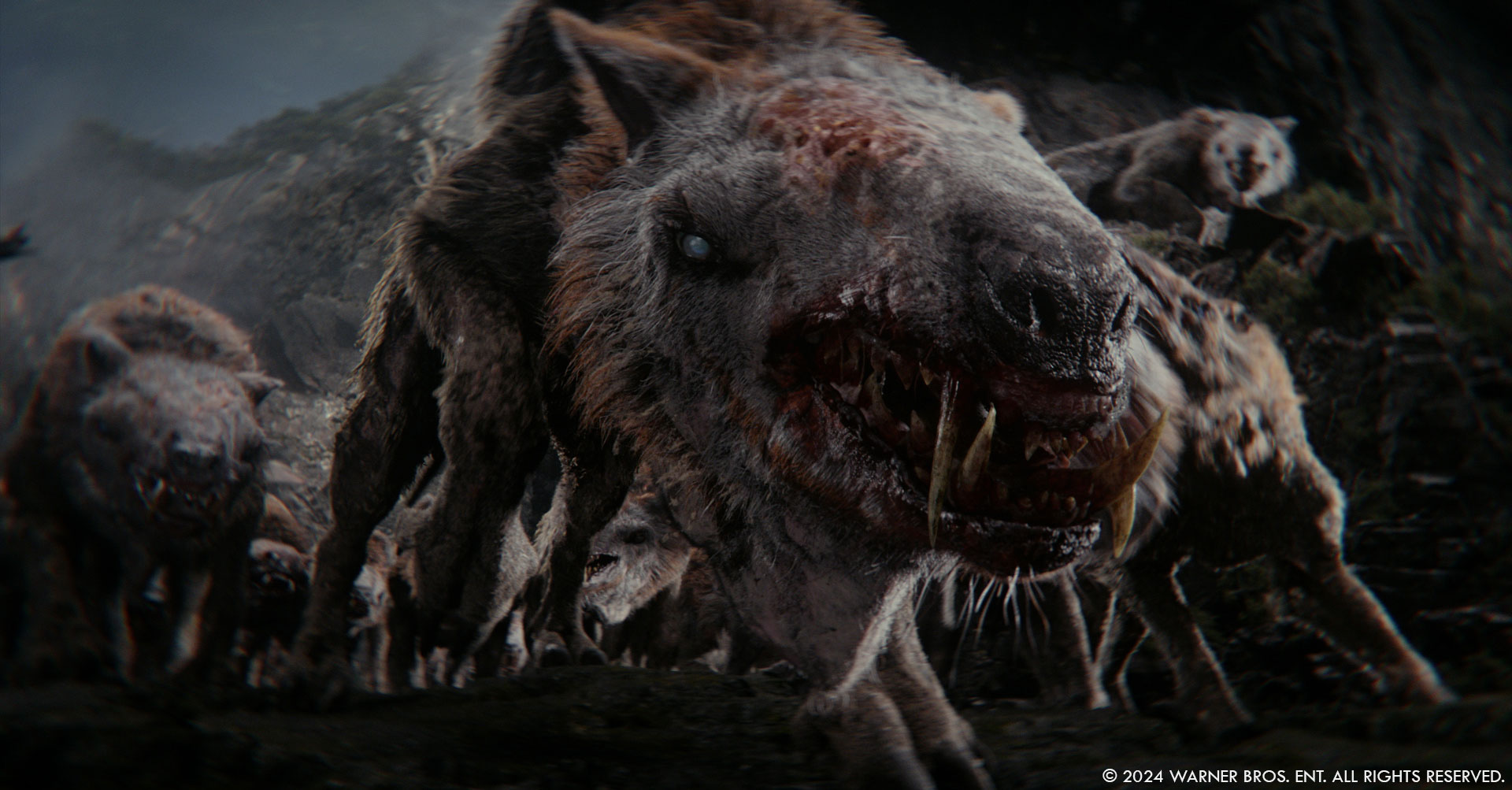
How did you organize the work between you and with your VFX Producer?
Nick // Scanline’s Zac Mallett is a gem of a VFX Producer, and his robust knowledge of the VFX Process was really a huge advantage for me and the entire Scanline team. Zac and I have a long history of working together, and it made this collaboration fairly straightforward.
Early on we empowered our Supervision team to run with their respective areas of focus. Eric handled all things creature performance and animation, DFX Supervisor Jono Friesler handled FX, CFX, Crowds, Asset Development, and other special projects while CG Supervisor Amir Eleswy spent his time focusing on layouts through environment builds. Ashwin Karthik in lighting, Comp Supervisors Alan Stucchi and Amanda Roop, as well as VFX Art Supervisor Cameron Thomas were all very integral to the team, each playing key roles in getting this show’s volume and complexity delivered to the highest standards, especially with a team spread across seven locations throughout the globe.
What are the sequences made by Scanline VFX?
Nick // Our primary sequences were the Opening Sequence, the Cairo / Pyramid Fight, and the final battle in Rio de Janeiro. Additionally, we worked on the beginning portion of the Ape Fight sequence (until Kong travels through the waterfall), the Crawl Back / Under Repair Sequences (where Kong retreats and powers up with his arm brace), additional Hollow Earth builds in the ‘The Ruins’ and ‘Destroyed Base’ sequences, as well as the introduction of Mothra at the pyramids. There were also a few additional vignettes / shots we helped out with throughout the film.
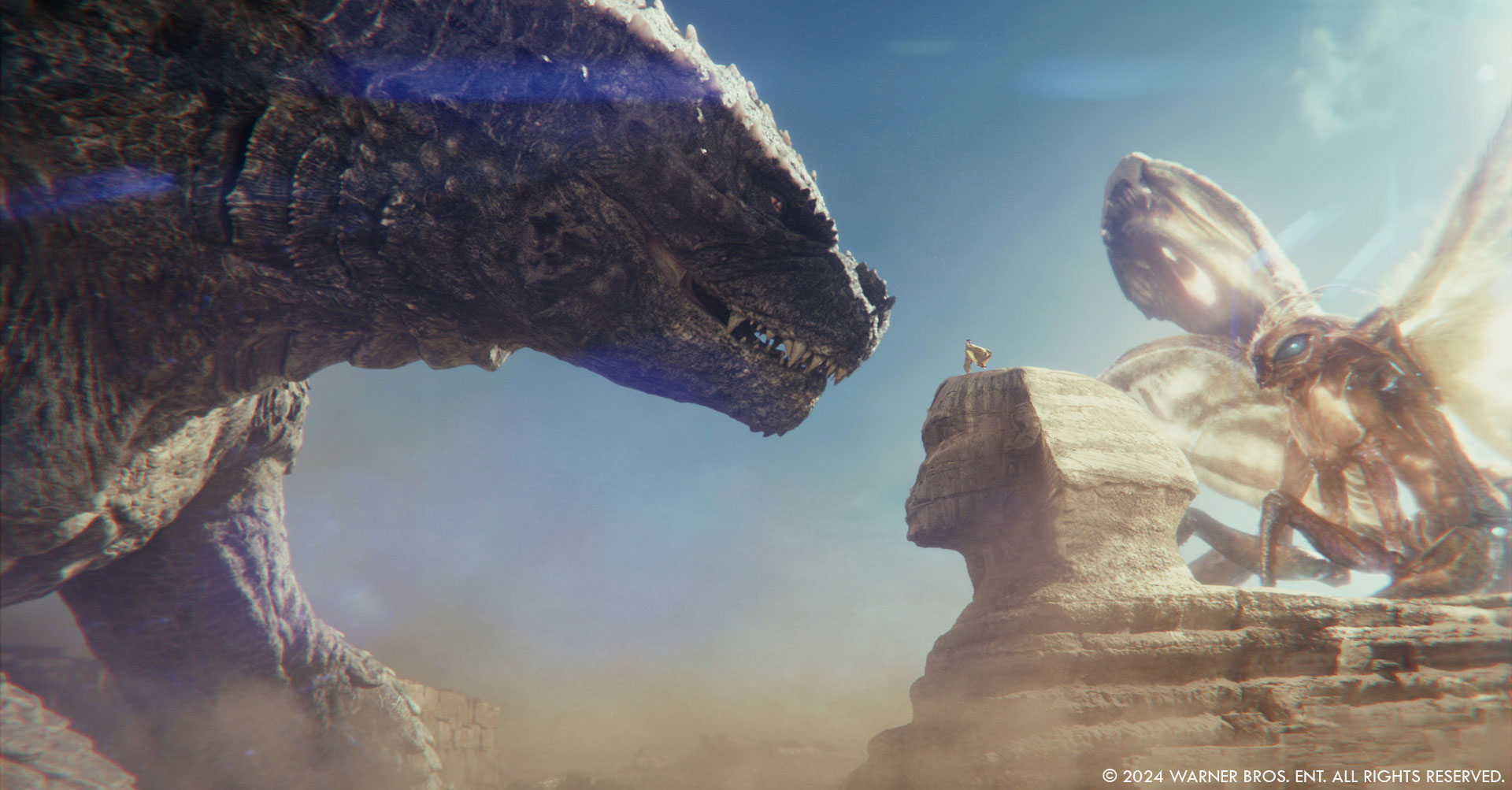
Could you elaborate on the technical challenges faced when creating the visual effects for Kong, Godzilla and Mothra, particularly in terms of conveying their massive scale on screen?
Nick // A big challenge we had on the film was speed vs. scale. Since Adam preferred quick, action heavy sequences with a focus on Titan vs Titan conflict, the majority of the action beats were previsualized to be fast-paced and action packed at the Titan’s perceived scale. However, from a human’s eye, the characters would be moving much slower. Therefore, we had to decide, case-by-case, if we favored creature performance or real world physics in any of the given scenes. This obstacle was ultimately overcome through a close collaboration with Animation, Environments, FX and comp to try and create appropriate solutions based on location, action beat, and story.
Another particularly large hurdle on this show was in environments. The degree of environment builds, especially with our real world locations, was especially challenging. The variety, complexity, and sheer volume of digital environments were enormous, and the detail level and FX-Friendly nature was additionally quite a large challenge, especially while trying to work with an efficient budget and timeline.
What innovative techniques were employed in animating Kong, Godzilla and Mothra to ensure their movements appeared realistic and proportional to their colossal size?
Eric // I’d love to say that we developed some innovative methods to achieve that effect, but in the end it always comes down to leaning heavily into animation fundamentals. In this case that meant walking a very tight line regarding weight, inertia and momentum, and in particular – speed. We needed to find a balance between the fact that creatures of that size would, in reality, visually move quite slowly – with the need to keep the action punchy and exciting. Those decisions were aided by the context of the sequence – is it in Hollow Earth? Is it taking place around humans? Alessandro worked with us to find that balance in the early stages, coining the term « Titan-time » to describe how the Titans, when seen outside of the context of humans, could move at a speed we’d be more familiar with at a human scale. When they were viewed from a human perspective – for example a street level camera in a city on the surface – we would need to stay more true to their massive scale.
Technique-wise we used a shot-dependent mix of keyframe and motion capture across our work with the bipedal creatures. We found that performing with just a little extra deliberation – a bit slower, heavier, and with more thought behind every motion – gave us better results than simply slowing down captured motions.

Given the immense scale of Kong, Godzilla and Mothra, how did the visual effects team approach integrating these creatures seamlessly into live-action footage, ensuring they interacted convincingly with their environment and human characters?
Nick // For the integration of live action footage with our digital titans, there were a few factors to watch out for. As we did on location in Rio, Ale and the VFX team had an ability to view the Titans via a VR viewfinder live on location – making sure we were framing for the massive size of our titans. This meant for a more realistic camera move and blocking of the talent. After plate photography, we always made sure we had that location scanned, with photographic reference for digital rebuild along with an HDRI for lighting.
In post production, these shots always ended up having our Titan’s animation slowed down, since they needed to be perceived more from a human’s relative perspective.
What were some of the key technical and artistic challenges faced by your team when conceptualizing and creating the Kong’s Power Glove Arm?
Eric // Like any major element in a film like this, it began with concepts from the production art department. Starting with awesome concepts is something which always gets everyone excited, and we were eager to build upon that foundation to produce a final design that would fit the requirements of Kong’s action-heavy performance. Ale was happy to have us continue the conceptual development in 3D with an eye toward its in-shot use. Nick Lloyd, our veteran Scanline concept artist on the project, was able to re-imagine the concept work in a rigged and animatable context, then modeled revised mechanisms against our Kong production rig, and worked with myself and Bill to reduce performance hindering interpenetrations and other engineering nightmares.
Many of the artistic challenges stemmed from the fact that the Arm Brace was meant to have been built using similar design language to the mule vehicle – a VTOL Cargo ship, the same used in the delivery of the brace piloted by Trapper – so it was important to incorporate recognizable bits, parts which could give hints of human use – such as ladders for scale – without filling the design with clutter, or making it feel unsubstantial or weak.
The final challenge was designing the brace’s transformation into its « power punch mode. » This was conceptualized in animation by moving parts around, and adding improvised bits, before sending it all back to the modeling and rigging teams to reconcile into the final rig used in the film.
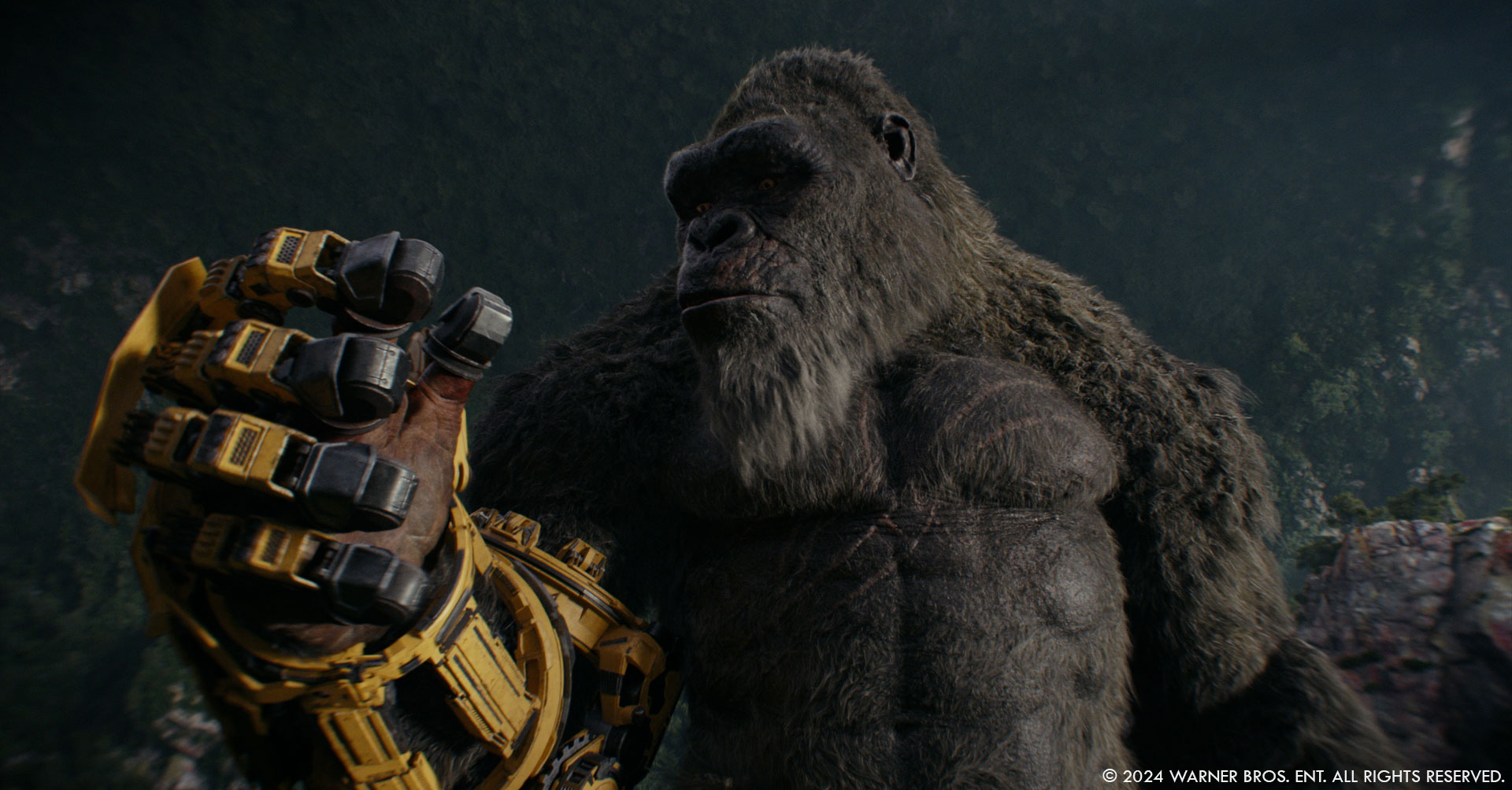
Can you walk us through the creative process behind designing the Hollow Earth and the Pyramids environments?
Nick // Hollow Earth builds were quite a different beast then the Pyramids environment, specifically in that one is real world and the other is fictitious.The Pyramid environment was a tangible location where we leaned into known photography, mapping coordinates, and various videos we could find of these locations. This process gave our ENV team and Supervision team the answer key, and made notes and approvals straightforward (while still taking time and effort).
From a Hollow Earth perspective, the environment work quickly could become untethered from reality, so our challenge was to always ride the line of making it creatively interesting, while also balancing story tone and grounding the design with real world reference. Before we started our work, Ale shot some amazing material in Iceland, and we grafted those details throughout our work to help ground our builds in photorealism. Overall it was an interesting balance of creating visually striking environments that had a uniqueness to them, while still grounding them with earth-like features that the audience could connect with, yet keeping that massive scale.
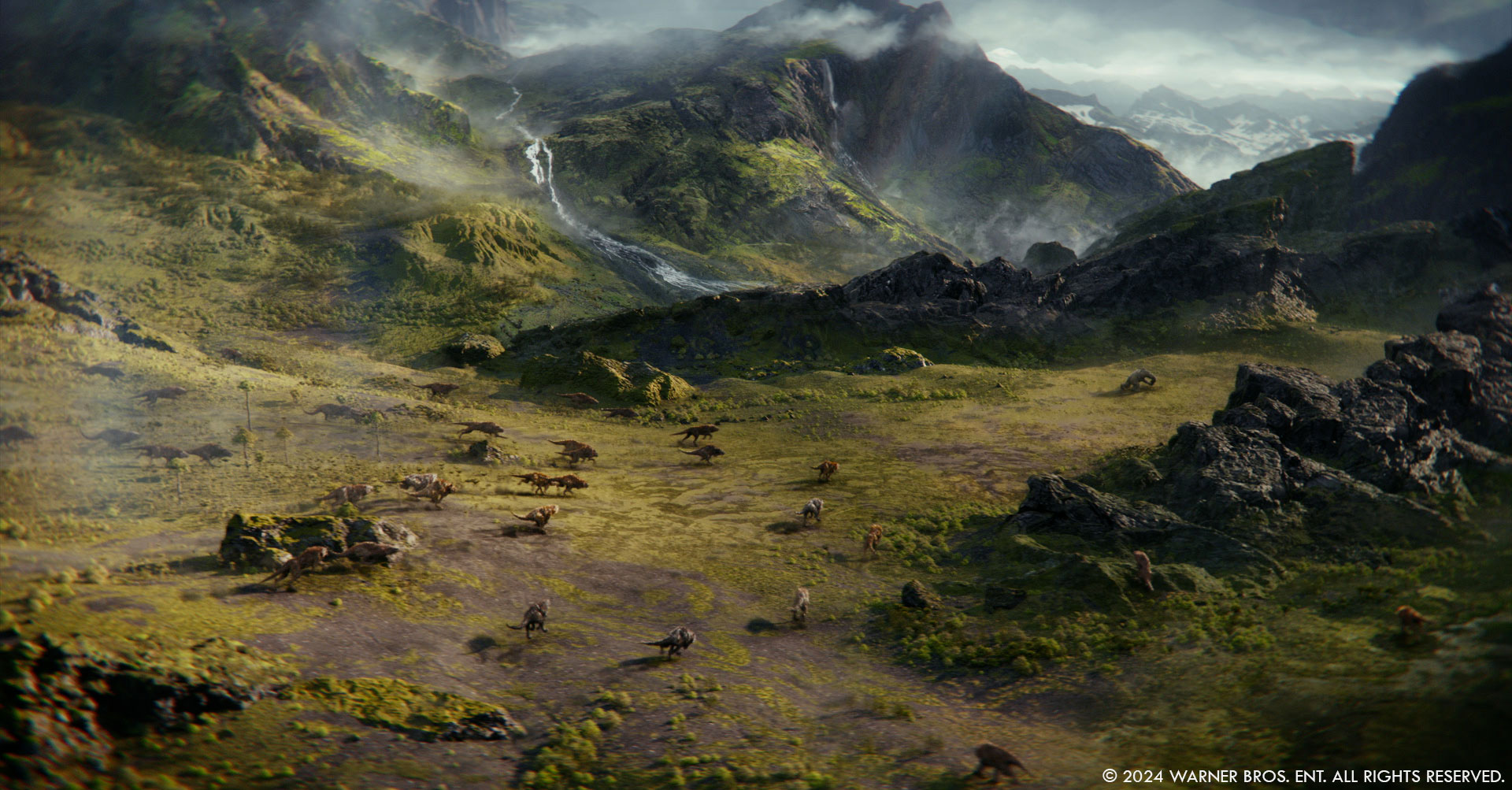
Could you elaborate on the intricate process behind creating the visually stunning effects for the epic showdown between Kong and Godzilla amidst the backdrop of the Egyptian pyramids?
Nick // Ale kicked off this sequence with some developed previs, which gave us a great starting point! Once turned over, our team began breaking down the previs into beats, and placing them into scale-appropriate layout scenes that were true to the real world location. From there, we tried to find the best photographic references of those areas, grouping our highly viewed parts of Cairo and the pyramids into ‘jump cameras’ that our modeling, surfacing and environments team began building. This process was masterfully executed with great leadership from DFX Supervisor Jono Friesler, CG Supervisor Amir Eleswy, and Environment Supervisor Thomas Warrender.
Eric and Bill’s animation team did a fantastic job of taking the flow from the previs, but also bringing their own ideas and polish to the various beats. This scene had quite a few moments of tension, prior to Kong and Godzilla really smashing each other, and it was in those moments from the animation team that we really were primed for a huge scale, satisfying showdown.
After we had our world built, and animation was ready, we got ready to do the fun stuff of destroying everything! FX Lead Will Wallace did most of our early development on this sequence, making sure we had great setups for pyramid destruction, ground impacts, dust simulations, grit passes, and more. Early on we really tried to make sure our setups had nice scale detail, speed and textural breakup, so when the viewer saw our shots, the gigantic scale we were trying to capture was visible.

In terms of the destruction depicted in the film, particularly around the iconic pyramids of Egypt, what were some of the key challenges your team faced in realistically portraying the chaos and devastation caused by the clash between these colossal titans?
Nick // I touched on it briefly above, but scale, speed, and detail were really challenging at our Titans’ scale. Ultimately the edit and fast-paced action were the primary driver for us, so we needed to conform our fx design to fit the pacing. Ultimately we ended up art directing this to the story beat specific requirements.
The Pyramid fight gave us some slower moments to really showcase the scale and slow speed of real world physics, while Rio ended up needing to pack A LOT of speed and action into a small amount of time.

Could you elaborate on the intricate process behind bringing the epic final battle in Rio de Janeiro to life through visual effects?
Nick // Rio was an absolute beast! Early on, it was evident that 90% plus of the shots in Rio would end up needing to be digitally created, so we got underway on a massive build of two primary areas, Copacabana Beach and the downtown area near the Lapa Arches.
CG Supervisor Amir Eleswy took lead on this build, both the construction of a gigantic portion of the city digitally, but also the challenge of maintaining destruction continuity as the massive five-way Titan battle unfolded. What this ended up meaning is an initial ‘non-destroyed’ build (which needed to be built for destruction), followed by a destroyed build.
Layout and Animation worked hand-in-hand with the environment build efforts to make sure we were being very clear on the needs per editorial beat, and per shot, so that the builds satisfied the needed points of the story.
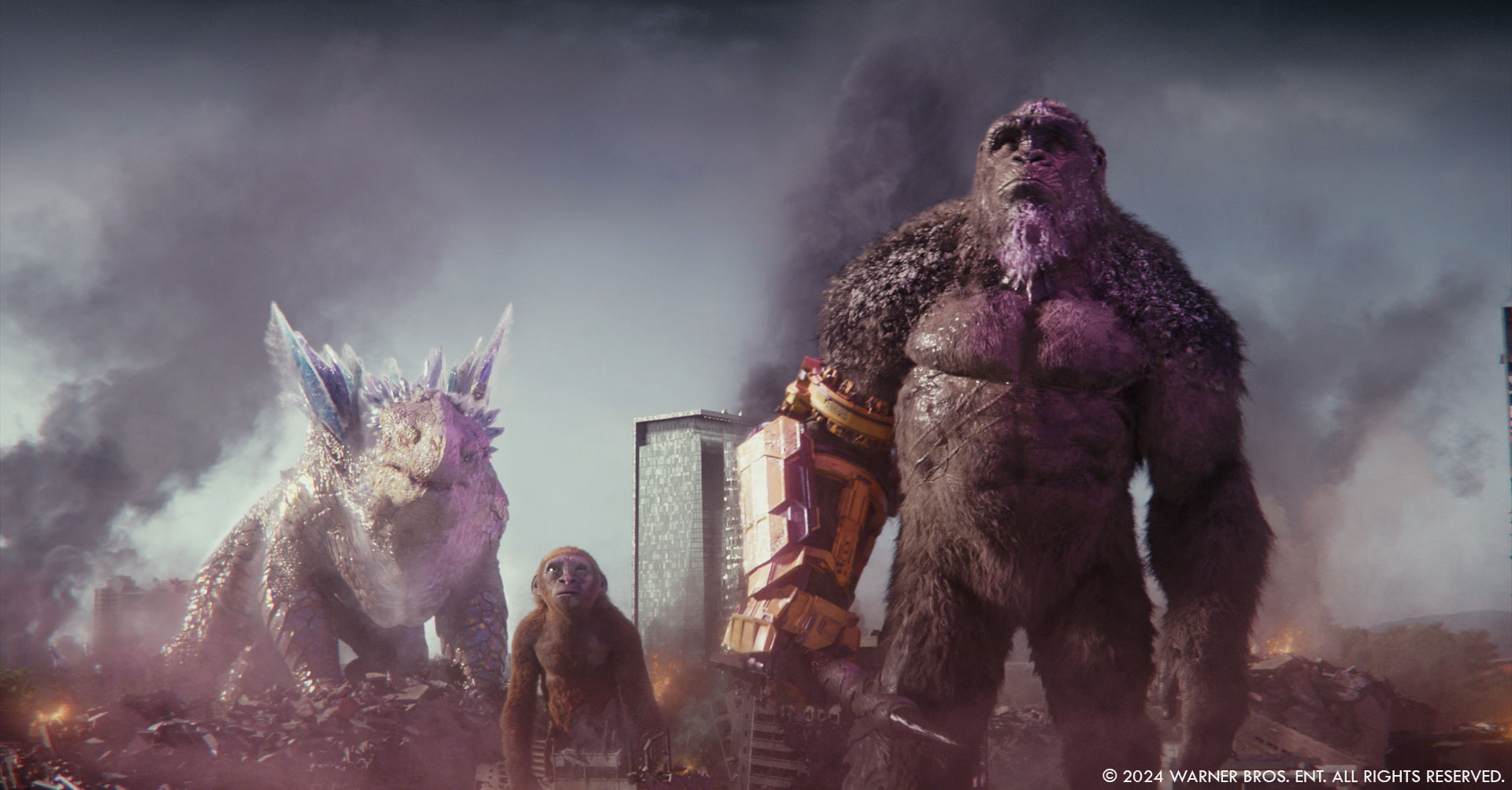
In particular, how were the colossal Titans, Kong and Godzilla, animated to convey their immense size and power during the intense combat sequences?
Eric // In addition to the delicate balance of speed and weight, I’d say crafting Titan performances with an awareness and understanding of the destruction they wreck on their surroundings – blocking that destruction along with their animation (and setting beats that would be further simulated in FX) – was key to conveying their power.
Not only was it very important to imagine the impacts and havoc they would wreak on the environment, but how it would, in turn, impact the Titans themselves. In the end, how much (or in some cases how little) they were affected by their surroundings as they battled one another helped convey each Titan’s respective size and power.
Once that blocking was established, it came down to the work of the FX team. Nothing sells scale and power like the way a Titan crumbles a building with a casual grab, or smashes a pyramid into rubble and dust as they carelessly fall through it. The detail and physics of Jono’s team’s simulation work was the element which both conveyed the earth shattering power of these beasts, but also grounded it.
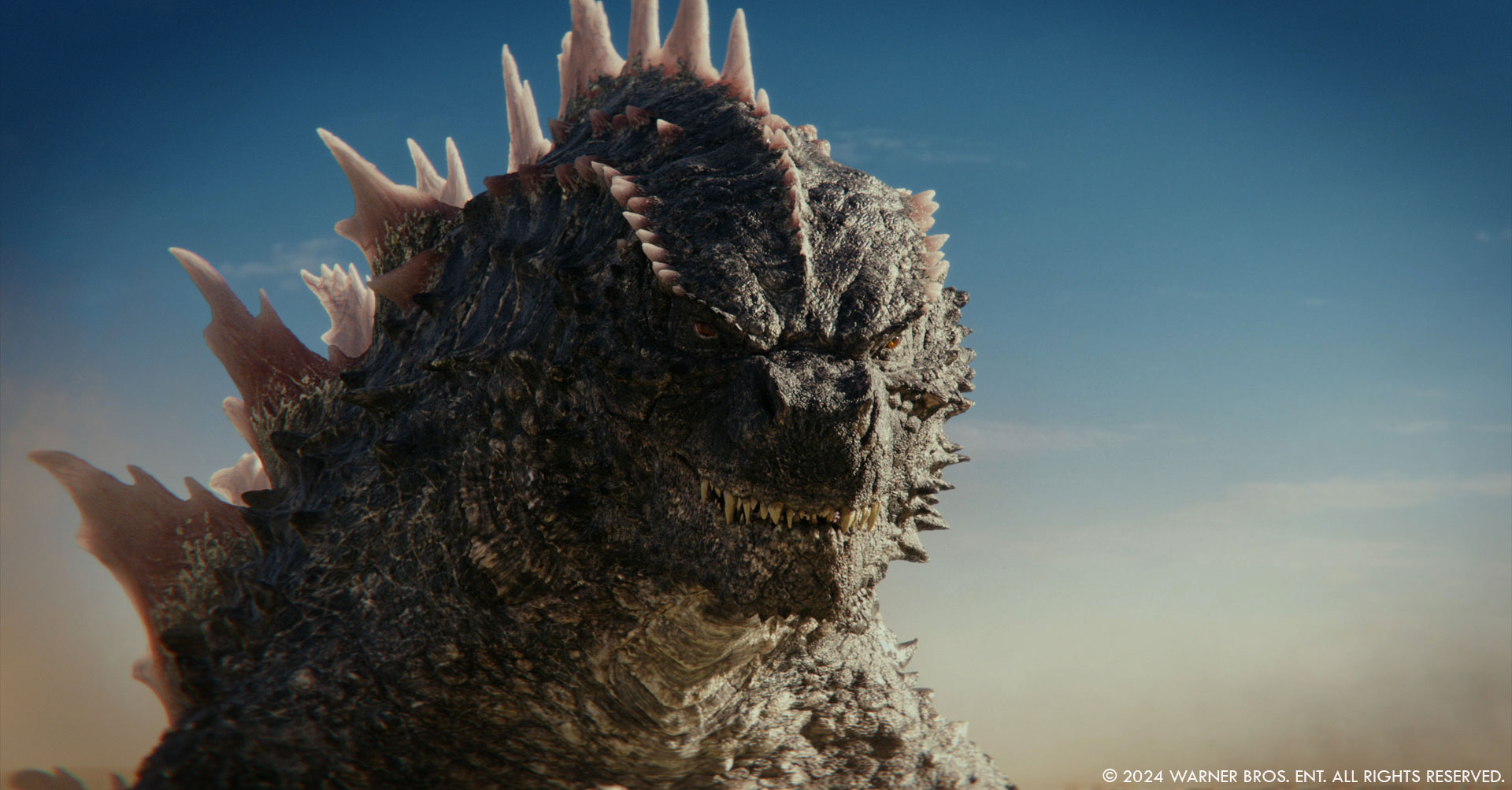
The final battle scene showcases numerous scenes of massive destruction throughout Rio de Janeiro. Can you walk us through the methodology used to realistically depict these catastrophic events while maintaining a sense of visual coherence and storytelling clarity?
Nick // DFX Supervisor Jono Freisler and FX Supervisor Shareef Shanawany took the lead on making sure the destruction efforts were streamlined, working closely with the entire FX team at Scanline. The sequence was meticulously broken down by FX item per shot (which were many… on every shot 🙂 ), and tasked out to the appropriate artist we knew would excel at that task. From there, a lot was thrown at compositing, led by Compositing Supervisor Alan Stucchi and Art Supervisor Cameron Thomas, to shape each shot to the visual coherence necessary.
Given the complexity of the visual effects involved in the creation of the final battle, what were some of the most significant technical and creative challenges the team encountered, and how were they overcome to deliver such a visually stunning and emotionally resonant sequence?
Nick // From a technical standpoint, keeping everyone’s efforts organized and pulling together as one team on a complexity level of this sequence was most challenging in my mind. With five titans to animate, multiple different muscle simulations and groom sims, creature interaction, creature effects, environment detailing, environment destruction, atmospherics, destruction history, all with complex lighting and comp…. It was a challenge to keep everything moving together toward an extremely high end product. The entire team really had to be on point to get this completed!
Creatively, the challenge really became stepping back from all that technical complexity, and trying to view each shots’ needs and aesthetics. Each shot needed to be shaped and polished based off of the editorial beats and story conveyed, so making sure the end product satisfied these points, looked photographically believable, and respected the Titan’s scale was a constant challenge.
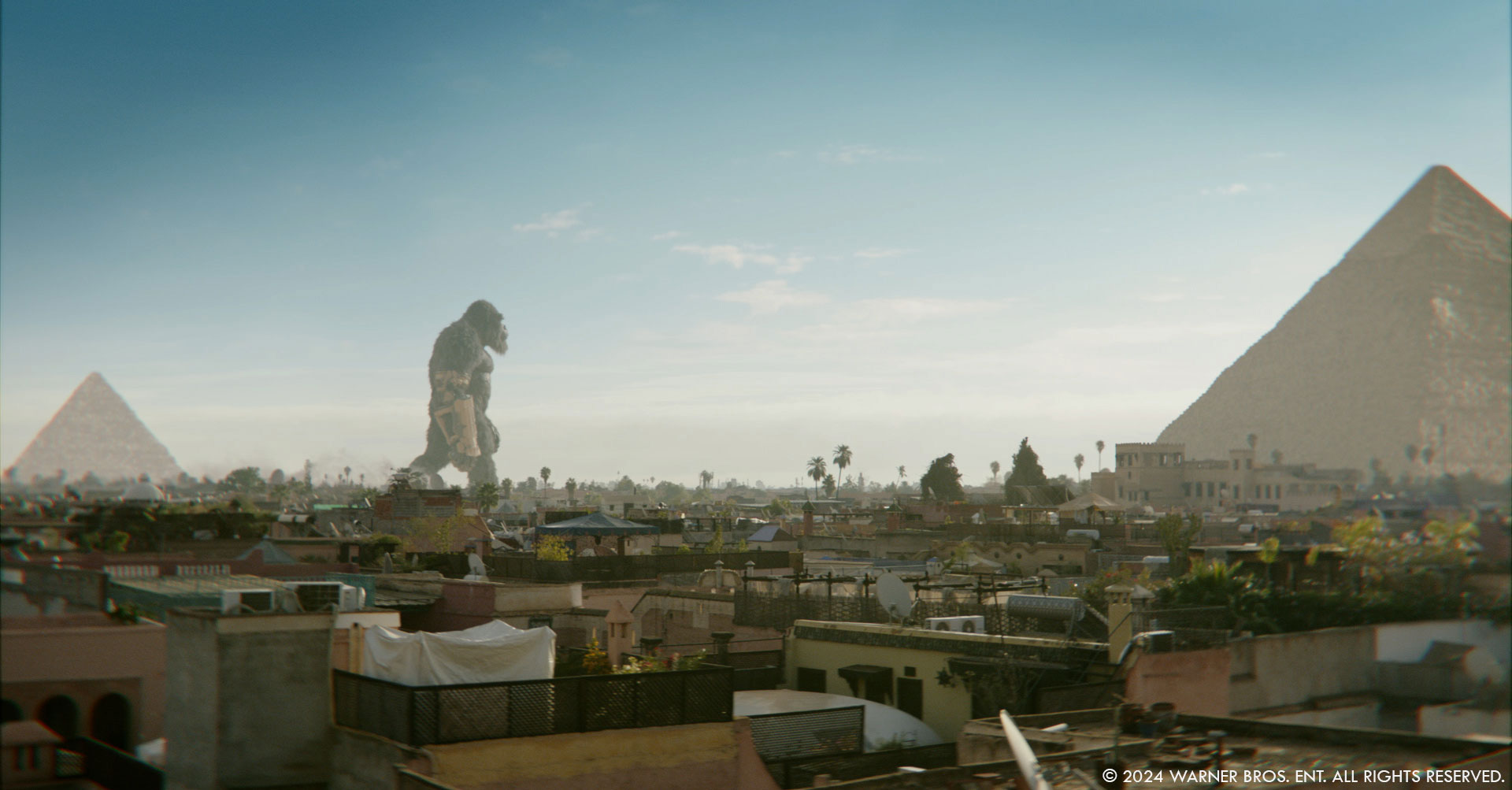
Were there any memorable moments or scenes from the film that you found particularly rewarding or challenging to work on from a visual effects standpoint?
Nick // It’s still a little fresh for me, but I think the Pyramid Fight and the battle in Rio were both very challenging, as well as extremely rewarding. Both sequences really stress-tested our team in technical planning, creative exploration of FX, and overall team work due to the extremely wide variety of VFX that were necessary in these sequences.
Looking back on the project, what aspects of the visual effects are you most proud of?
Nick // Pyramid Fight, the battle in Rio, and the world building in Hollow Earth are all neck-and-neck for me. The team did a fantastic job to pull these off.

Which sequence or shot was the most challenging?
Nick // The Freezing Ice Wave at the head of the Rio De Janeiro sequence, followed by its shattering with Skar King landing on the beach was an especially challenging shot technically. We had dozens and dozens of simulations that needed to work together, hundreds of lighting renders to be assembled in comp, not to mention trying to nail the shot creatively to Ale and Adam’s liking.
Is there something specific that gives you some really short nights?
Nick // The Rio Sequence, particularly the Ice Wave shot mentioned above, ended up needing some later nights toward the end of the schedule.
What is your favourite shot or sequence?
Eric // Too many favourite shots!… but, I’d say the sequence with the greatest amount of them is probably the Cairo Pyramid fight.
Nick // I’m a bit partial to the Pyramid Fight myself, but I’m really proud of all of our team’s work throughout the film.

Tricky question, are you team Godzilla or King Kong?
Eric // Tricky indeed, I’d have to say Team Kong – he’s got so much attitude.
Nick // Team Kong!
What is your best memory on this show?
Eric // Among many great memories I think one of my favourites was during the later stages of production, when the animation team was near its peak size – and we had a team lunch. These days with so many of us working remotely it was great to bring that team together, get to know each other without a screen/webcam between us, and celebrate how the show was going. That and (Animation Supervisor) Bill Bridges breakdancing in the mocap suit.
Nick // There were lots of great memories of the show, but definitely one of my favorites was getting to watch an early cut with Alessandro at the Legendary offices to see the full scope and spectacle of the film.
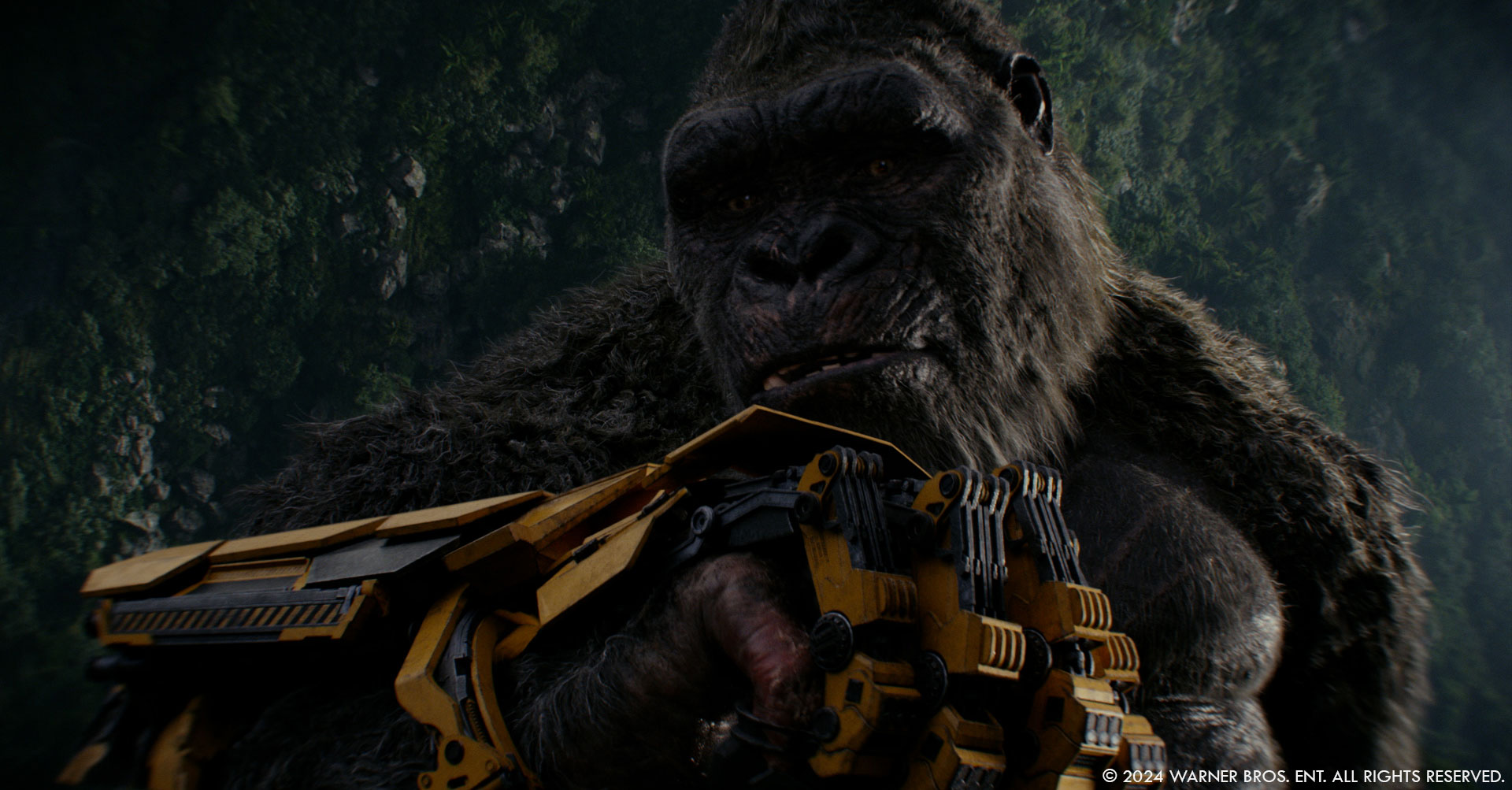
How long have you worked on this show?
Eric // I was involved with the film from October of 2022 though January 2024.
Nick // I was involved with the project about the same amount of time Oct ‘22 through Jan ‘24.
What’s the VFX shots count?
Nick // All in all we did about 29 minutes of the film’s run time (34.5 minutes with handles), and right about 453 shots + OMITS.
What is your next project?
Eric // I’m working on a Netflix comedy film – it involves creatures again, but this time on the opposite end of the size spectrum: insects!
Nick // I’ve stepped back into my role as Scanline’s Head of VFX, assisting our show teams globally across all of Scanline’s current slate.
What are the four movies that gave you the passion for cinema?
Eric // Putting me on the spot! – I think the films which most inspired my career choice would be:
- The Fifth Element
- The Thing
- Alien
- The Empire Strikes Back
- Honourable Mention: The Fly
A big thanks for your time.
WANT TO KNOW MORE?
Scanline VFX: Official website of Scanline VFX.
Alessandro Ongaro: Here’s my interview of Production VFX Supervisor Alessandro Ongaro.
© Vincent Frei – The Art of VFX – 2024






